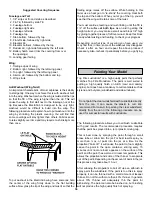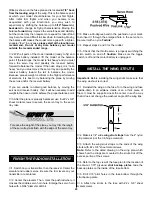
The Great Planes ElectriCub is a great-flying plane that flies
smoothly and predictably. The ElectriCub does not, however,
possess the self-recovery characteristics of a primary R/C
trainer and should only be flown by experienced RC pilots.
Switch on the transmitter, then the receiver. Make sure the
throttle stick is back (pulled towards you) before switching on
the motor toggle switch. Takeoff on “low” rates if you have dual
rates on your transmitter - especially if you are taking off into
a crosswind. As the plane accelerates the tail will begin to lift
and the plane will turn left (a characteristic of all taildraggers).
Be ready for this and correct by applying sufficient right
rudder to hold the plane straight down the runway. The
left-turning tendency will go away as soon as the tail is up and
the plane’s speed increases. Be sure to allow the tail to come
up. Do not hold the tail on the ground with up elevator, as the
ElectriCub will become airborne prematurely and possibly
stall. For all models it is good practice to gain as much speed
as the length of the runway will permit before lifting off. When
the plane has gained enough flying speed to safely lift off,
gradually and smoothly apply up elevator and allow the model
to climb at a shallow angle (do not yank the model off the
ground into a steep climb!)
We recommend that you take it easy with your ElectriCub
for the first several flights, gradually “getting acquainted”
with this great model. Add and practice one maneuver at a
time, learning how the ElectriCub behaves in each. Try to
stay within a sensible and realistic scale-like flight envelope.
Sometime well before it’s time to land, you should climb your
ElectriCub to a safe altitude, reduce the throttle and check
out the model’s low speed characteristics. Do this a few
times so you know what to expect upon landing and how the
ElectriCub handles stalls.
With electric planes it’s best to land with some battery
power left. This will allow you to abort the landing and go
around again if needed. When it is time to land, fly a normal
landing pattern and approach. Keep a few clicks of power on
until you are over the runway threshold. Then, reduce the
power to low and the ElectriCub will naturally bleed off
speed. Keep the nose down slightly, then level off just before
touchdown. For your first few landings, plan to land slightly
faster than stall speed and on the main wheels.
Have a ball! But always remember to think about your next
move and plan each maneuver before you do it. Impulsively
“jamming the sticks” without any thought is what gets most
fliers in trouble rather than lack of flying skill.
Happy Landings!
Landing
Flight
Takeoff
47


































